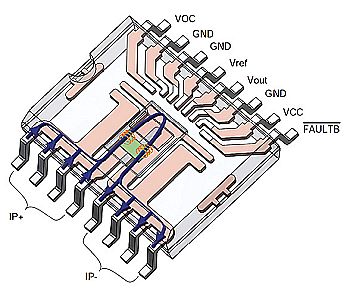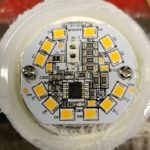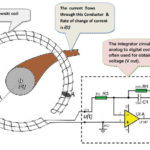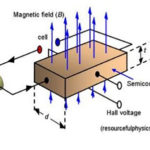Contactless current sensing provides the fast response that state-of-the-art power circuits depend on.
Michael DiGangi • ACEINNA
The next generation of electronic products will be more powerful and flexible than ever. The advanced circuitry to drive them needs intelligent power management to realize the desired performance.
Application spaces like robotics and micro-electromechanical systems (MEMS) rely on higher-performing current-control systems. That’s where the current sensor comes in.

The explosion in portable and remote smart devices in the Cloud-enabled IoT has forced the industry to address energy storage. Issues go beyond increasing the energy density and charge/discharge rate. There must be intelligent monitoring of both the state of battery cells and their performance in the circuit. Parameters from temperature to output current must be known in real time.
The alternative to intelligent power management is brute-force approaches like fuses and circuit breakers. The problem is this approach risks catastrophic failure of the battery pack from thermal runaway or other types of failures. Breakers and switches work in low-power applications but rapidly run out of legroom in fast-switching high-power electronics.
A good example can be found in EV lithium-ion batteries. They require constant monitoring to protect against situations like high temperatures, overcharging, problematic discharging, short-circuits and other failure events. These can arise during both charging and use, but the high currents involved in EV rapid-charging systems make the charging process a serious safety issue demanding intelligent power management.
State-of-the-art batteries used in the e-mobility and energy sector require a specialized Battery Monitoring Sensor (BMS) to cope with operational and safety requirements. These systems typically employ advanced monitoring devices such as ACEINNA’s current sensors that provide fast, accurate and bidirectional current measurement.
The high energy densities and accelerated charge/discharge times of modern battery technology has fostered more stringent requirements for current sensing. High energy-density batteries such as lithium iron phosphate (LFP) or lithium-titanate (LTO) require coulomb counting to determine battery state of charge (SoC), state of health (SoH), and state of function (SoF). (The Coulomb counting method measures the discharging current of a battery and integrates the discharging current over time.)
EV manufacturers are trying to reduce charging time by increasing the working voltage. So EV battery voltages are rising, currently as high as 800 V. Silicon carbide (SiC) devices are well suited to operating at these voltages, as the variation of the transistor collector or drain current in the active or the saturation region of operation with the VCE or VDS is less than that of ordinary silicon-based transistors.
Next-generation EV chargers need advanced current measurement to detect faults fast and get real-time performance information. To address issues raning from ground faults to extreme loading conditions, current sensors provide feedback for the control loops in advanced charging systems.
Also important in EVs (and in many industrial motor-drive applications as well) is the traction inverter. Advanced current sensing here serves as a proxy for torque control.
Sensing techniques
Shunt current sensors are basically low-value, precision resistors. They sit in the conduction path between a power source and a load. The voltage drop across the resistor is proportional to the current flowing through it. to determine the current flowing through it. Shunt resistors have a maximum current rating, and the resistance value is typically given by the voltage drop at the maximum current rating. For example, a shunt resistor rated for 200 A and 50 mV has a resistance of 50/200 = 0.25 mΩ. The voltage drop at maximum current is typically rated at 50, 75 or 100 mV.
Resistive current shunts have limitations at high and low currents. At high currents the resistive material in the shunt itself can heat up enough to change the resistance. Shunt resistors usually have a derating factor of 66% for continuous operation, meaning a run time longer than two minutes. High temperatures degrade the accuracy of the shunt. Above 80 °C, thermal drift starts and worsens as temperature rises. Above 140°C the resistor may be damaged, and the resistance value may permanently change.
In contrast, such problems typically don’t affect contactless current sensors. Examples include contactless ACEINNA current sensors. They provide galvanic isolation and the load and consume no load power. In addition, contactless sensing enables faster readout while correcting offsets via active feedback loops, adjusting the gain parameters and actively compensating the sensor offset. Integrated sensing also offers significant footprint savings over board assembled approaches. Built using an op-amp and comparator, the size of a discrete implementation will be larger than an IC version.
Overcurrent sensing is important not just for high-power applications like EV chargers. It’s also key for protecting delicate electronics in applications like in-patient medical sensors. Current-sensors like those from Aceinna are well suited for detecting overcurrent thanks to their fast response and large current measurement range. Because they are isolated, contactless current sensors can be used on both the high and low sides of the circuit. Used along with AMR sensors (Anisotropic Magneto-Resistive sensors are contactless and measure the changes in the angle of a magnetic field as seen by the sensor and can be used for presence detection.) and temperature correction, they reduce the complexity of the customer design.
Current sensors also play a role in measuring power factor for ac power factor correction (PFC) circuits. PFC circuits reduce the harmonic distortion in the supply current and create a current waveform close to a fundamental sine wave to increase the power factor to unity. Power factors below one result in more current needed to perform the same work. PFC produces reactive energy in opposition to the energy absorbed by loads such as battery chargers close to the load to improve the power factor. Aceinna current sensors not only simplify the overall system design, they also reduce the cost of implementation.
In a nutshell, application spaces like in-home fast charging require use of advanced current sensing to optimize the WBG-based systems in the latest power-management solutions.









Leave a Reply